Anaconda
2008/9 Schools Wikipedia Selection. Related subjects: Insects, Reptiles and Fish
| Eunectes | ||||||||||||||||||
|---|---|---|---|---|---|---|---|---|---|---|---|---|---|---|---|---|---|---|
 Green anaconda, E. murinus
|
||||||||||||||||||
| Scientific classification | ||||||||||||||||||
|
||||||||||||||||||
| Synonyms | ||||||||||||||||||
|
- Common names: anacondas.
Eunectes is a genus of non-venomous boas found in tropical South America. An aquatic group of snakes inhabiting swamps and rivers, its members include some of the largest snakes in the world. Despite this, little was known about them until recently. The name Eunectes is derived from the Greek word Eυνήκτης, which means "good swimmer." Three species are currently recognized.
Description
There is some debate about the maximum size of these snakes. Mehrtens (1987) states that the average adult length for the green anaconda, E. murinus, is 18 to 20 feet (5.5–6.1 m), with 25 feet (7.6 m) specimens being very rare. He sets a more conservative maximum at 23 feet (7.0 m). Estimates of 35 to 40 feet (11–12 m) are based on vague data and should be regarded with caution. In a study of 1,000 specimens captured in Venezuela, the largest was 17 feet (5.2 m) long and weighed 100 pounds (45 kg).
The Wildlife Conservation Society has, since the early 20th century, offered a large cash reward (currently worth US$50,000) for live delivery of any snake of 30 feet (9.1 m) or more in length. This prize has never been claimed. In any case, measuring a snake that is stronger than the person is not an easy task. It was found that two scientist independently measuring the same 12-foot (3.7 m) plus snake showed a variation of more than 20% in their results.
Common names
Local names in South America include the Spanish term "matatoro," meaning "bull killer," and the Native American terms sucuri and "yakumama."
There are two possible origins for the common name "anaconda." The first is a Tamil word "anaikondran," meaning "elephant killer." A name first used in English to name a Ceylonese python, it erroneously was applied to a large South American boa, called in Brazil "sucuri". The word is of uncertain origin, and no snake name like it now is found in Sinhalese or Tamil. Another suggestion is that it represents Tamil anaikkonda "having killed an elephant." It is unclear how this name originated so far from the snake's native habitat; possibly this is due to its vague similarity to the large Asian pythons.
Geographic range
Found in tropical South America from Colombia and Venezuela south to Argentina.
Reproduction
Ovoviviparous, with females giving birth to live young.
Captivity
There have been very few instances of this species being bred in captivity. In October 2007, the New England Aquarium in Boston achieved a breakthrough when it was discovered that one of their females was gravid. Fourteen young were born on January 1, 2008.
Species
| Species | Authority | Subsp.* | Common name | Geographic range |
|---|---|---|---|---|
| E. deschauenseei | Dunn & Conant, 1936 | 0 | Dark-spotted anaconda | South America in northeastern Brazil and coastal French Guiana. |
| E. murinusT | (Linnaeus, 1758) | 1 | Green anaconda | South America in countries east of the Andes, including Colombia, Venezuela, the Guianas, Ecuador, Peru, Bolivia, Brazil and on the island of Trinidad. |
| E. notaeus | Cope, 1862 | 0 | Yellow anaconda | South America in eastern Bolivia, southern Brazil, Paraguay and northeastern Argentina. In Argentina it is found in the provinces of Corrientes, Chaco, Entre Rios, Formosa, Misiones and Santa Fe. |
*) Not including the nominate subspecies.
T) Type species.